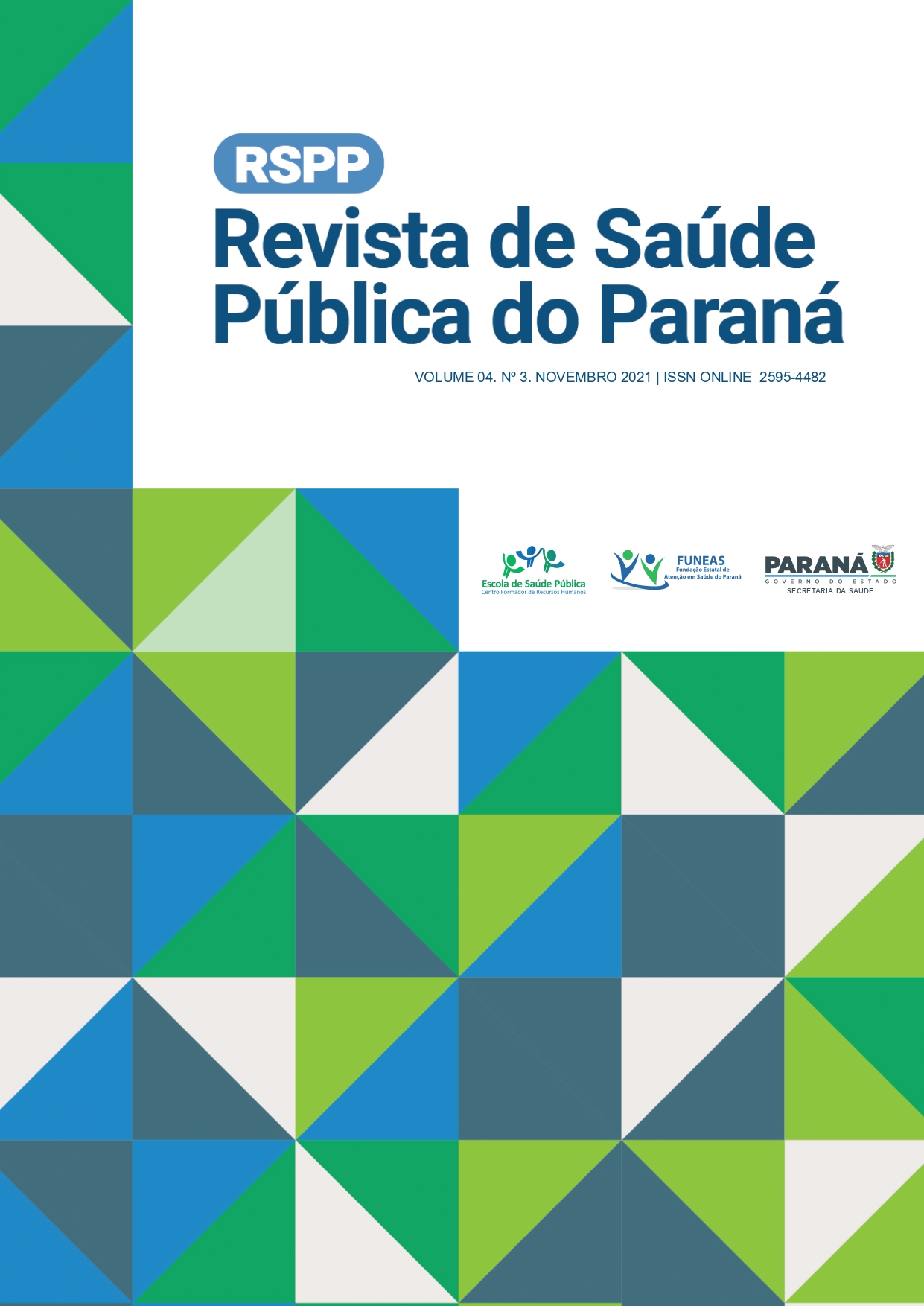Incidentes e eventos adversos em segurança do paciente: uma série temporal de 2019 a 2020
Resumo
Trata-se de uma análise de série temporal que objetivou caracterizar o perfil de incidentes e eventos adversos associados à segurança do paciente, na região sudeste entre julho de 2019 e junho de 2020. Para fins de associação e análise de tendência, foram utilizados os testes G de independência e Mann-Kendall, respectivamente. Do total de 59.822 incidentes, 76,9% (46.336) acarretaram eventos adversos ao paciente. Houve associação entre falhas envolvendo cateteres venosos e dano leve nos estados do Espírito Santo (87,4%;p<0,0001) e Rio de Janeiro leve (66,2%;p<0,0001). Em São Paulo (24,1%;p<0,0001) e Minas Gerais (30%;p<0,0001), as lesões por pressão associaram-se ao dano moderado. Quanto ao número de notificação de incidentes, registraram-se tendências decrescentes no Espirito Santo e Rio de Janeiro. Portanto, evidenciou-se elevado número de eventos adversos de dano moderado, além de tendências decrescentes nas notificações em alguns estados requerendo monitoramento e avaliação contínua de falhas na assistência para evitar subnotificações.
Referências
2. Institute of Medicine (US) Committee on Quality of Health Care in America, Kohn LT, Corrigan JM, Donaldson MS, eds. To Err is Human: Building a Safer Health System. Washington (DC): National Academies Press (US); 2000. doi: https://doi.org/10.17226/9728
3. Mendes GHS, Mirandola TBS. Acreditação hospitalar como estratégia de melhoria: impacto em seis hospitais acreditados. Gest Prod. 2015;22(3):636-48. doi: https://doi.org/10.1590/0104-530X1226-14
4. World Health Organization (WHO). World Alliance for Patient Safety. Forward Programme 2008-2009. Geneva (Switzerland): World Health Organization; 2008. [citado em 2021 Jul 2919]. Disponível em: https://apps.who.int/iris/bitstream/handle/10665/70460/WHO_IER_PSP_2008.04_eng.pdf?sequence=1&isAllowed=y
5. Zanetti ACB, Gabriel CS, Dias BM, Bernardes A, Moura AA, Gabriel AB, et al. Assessment of the incidence and preventability of adverse events in hospitals: an integrative review. Rev Gaucha Enferm 2020;41:e20190364. doi: https://doi.org/10.1590/1983-1447.2020.20190364
6. Aitken M, Gorokhovich L. Advancing the Responsible Use of Medicines: Applying Levers for Change. Parsippany (NJ): IMS Institute for Healthcare Informatics; 2012. [citado em 2021 Jul 18]. Disponível em: https://ssrn.com/abstract=2222541
7. WHO guidelines for safe surgery 2009: safe surgery saves lives. Geneva: World Health Organization; 2009. [citado em 2021 Jul 18]. Disponível em: http://apps.who.int/iris/bitstream/handle/10665/44185/9789241598552_eng.pdf
8. Agência Nacional de Vigilância Sanitária (Brasil). Gestão de Riscos e Investigação de Eventos Adversos Relacionados à Assistência à Saúde. Brasília: Anvisa, 2017. [citado em 2020 Dez 29]. Disponível em: https://www.segurancadopaciente.com.br/wp-content/uploads/2017/09/Caderno-7-Gest%C3%A3o-de-Riscos-e-Investiga%C3%A7%C3%A3o-de-Eventos-Adversos-Relacionados-%C3%A0-Assist%C3%AAncia-%C3%A0-Sa%C3%BAde.pdf
9. Chamberlain-Webber J. Seven steps to patient safety. Professional nurse. 2004;20(3):10-4. doi: http://dx.doi.org/10.1016/S1134-282X(08)74725-0
10. Agência Nacional de Vigilância Sanitária (Brasil). Incidentes relacionados à assistência à saúde - Resultados das notificações realizadas no Notivisa - Brasil, julho de 2019 a junho de 2020. Brasília: Anvisa, 2020. [citado em 2020 Dez 29]. Disponível em: https://www.gov.br/anvisa/pt-br/centraisdeconteudo/publicacoes/servicosdesaude/relatorios-de-notificacao-dos-estados/eventos-adversos
11. Agência Nacional de Vigilância Sanitária (Brasil). Implantação do Núcleo de Segurança do Paciente em Serviços de Saúde. Brasília: Anvisa, 2015 [citado em 2020 Dez 29]. Disponível em: https://www.saude.go.gov.br/images/imagens_migradas/upload/arquivos/2017-09/2016-anvisa---caderno-6---implantacao-nucleo-de-seguranca.pdf
12. Sinclair D, Croskerry P. Patient safety and diagnostic error: tips for your next shift. Can Fam Physician. 2010;56(1):28-30. Disponível em: https://www.ncbi.nlm.nih.gov/pubmed/20090077
13. Suliman M, Saleh W, Al-Shiekh H, Taan W, AlBashtawy M. The Incidence of Peripheral Intravenous Catheter Phlebitis and Risk Factors among Pediatric Patients. J Pediatr Nurs. 2020; 50:89-93 doi: https://doi.org/10.1016/j.pedn.2019.11.006
14. Yoshida T, Silva A, Simoes LLP, Guimaraes RA. Incidence of Central Venous Catheter-Related Bloodstream Infections: Evaluation of Bundle Prevention in Two Intensive Care Units in Central Brazil. T ScientificWorldJournal. 2019;2019:1025032. doi: https://doi.org/10.1155/2019/1025032
15. Bereded DT, Salih MH, Abebe AE. Prevalence and risk factors of pressure ulcer in hospitalized adult patients; a single center study from Ethiopia. BMC Res Notes. 2018;11(1):847. 10.1186/s13104-018-3948-7. doi: https://doi.org/10.1186/s13104-018-3948-7
16. Bicer EK, Gucluel Y, Turker M, Kepicoglu NA, Sekerci YG, Say A. Pressure Ulcer Prevalence, Incidence, Risk, Clinical Features, and Outcomes Among Patients in a Turkish Hospital: A Cross-sectional, Retrospective Study. Wound Manag Prev. 2019;65(2):20-8. Disponível em: https://www.hmpgloballearningnetwork.com/site/wmp/article/pressure-ulcer-prevalence-incidence-risk-clinical-features-and-outcomes-among-patients
17. Miliani K, Taravella R, Thillard D, Chauvin V, Martin E, Edouard S, et al. Peripheral Venous Catheter-Related Adverse Events: Evaluation from a Multicentre Epidemiological Study in France (the CATHEVAL Project). PLoS One. 2017;12(1):e0168637. doi: https://doi.org/10.1371/journal.pone.0168637
18. Pacha HHP, Faria JIL, Oliveira KA, Beccaria LM. Pressure Ulcer in Intensive Care Units: a case-control study. Rev Bras Enferm. 2018;71(6):3027-34. doi: https://doi.org/10.1590/0034-7167-2017-0950
19. Bouldin EL, Andresen EM, Dunton NE, Simon M, Waters TM, Liu M, et al. Falls among adult patients hospitalized in the United States: prevalence and trends. J Patient Saf. 2013;9(1):13-7. doi: https://doi.org/10.1097/PTS.0b013e3182699b64
20. Stevens JA, Mack KA, Paulozzi LJ, Ballesteros MF. Self-reported falls and fall-related injuries among persons aged ≥65 years–united states, 2006. Journal of Safety Research 2008;39:345–9. doi: https://doi.org/10.1016/j.jsr.2008.05.002
21. Hughes RG. Tools and Strategies for Quality Improvement and Patient Safety. In: Hughes RG, editor. Patient Safety and Quality: An Evidence-Based Handbook for Nurses. Advances in Patient Safety. Rockville (MD)2008. Disponível em: https://www.researchgate.net/profile/Ronda-Hughes/publication/49843307_Tools_and_Strategies_for_Quality_Improvement_and_Patient_Safety/links/573094e508ae6cca19a1e9b1/Tools-and-Strategies-for-Quality-Improvement-and-Patient-Safety.pdf
22. Maia CS, Freitas DRC, Gallo LG, Araújo WN. Notificações de eventos adversos relacionados com a assistência à saúde que levaram a óbitos no Brasil, 2014-2016. Epidemiol. Serv. Saúde [Internet]. 2018 [acesso em 2020 dez 23] ; 27(2): e2017320. doi: https://doi.org/10.5123/s1679-49742018000200004
23. Alves MFT, Carvalho DS, Albuquerque GSC. Motivos para a não notificação de incidentes de segurança do paciente por profissionais de saúde: revisão integrativa. Ciênc. saúde coletiva [Internet]. 2019 Aug [acesso em 2020 Dez 23]; 24(8): 2895-2908. doi: http://dx.doi.org/10.1590/1413-81232018248.23912017
24. Harper ML, Helmreich RL. Identifying Barriers to the Success of a Reporting System. In: Henriksen K, Battles JB, Marks ES, Lewin DI, editors. Advances in Patient Safety: From Research to Implementation (Volume 3: Implementation Issues). Advances in Patient Safety. Rockville (MD)2005. Disponível em: http://www.ahrq.gov/professionals/quality-patient-safety/patient-safety-resources/resources/advances-in-patient-safety/vol3/Harper.pdf
25. Mitchell I, Schuster A, Smith K, Pronovost P, Wu A. Patient safety incident reporting: a qualitative study of thoughts and perceptions of experts 15 years after 'To Err is Human'. BMJ Qual Saf. 2016;25(2):92-9. doi: https://doi.org/10.1136/bmjqs-2015-004405
26. Lorenzini E, Santi JA, Bao AC. [Patient safety: analysis of the incidents notified in a hospital, in south of Brazil]. Rev Gaucha Enferm. 2014;35(2):121-7. doi: https://doi.org/10.1590/1983-1447.2014.02.44370

This work is licensed under a Creative Commons Attribution 4.0 International License.





















